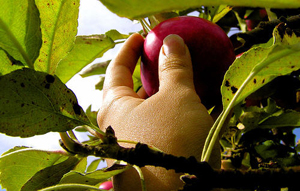In IT lingo, we have a term called ‘plug and play’. This term usually refers to devices that can be bought and used without complicated configuration or user intervention. Understandably, for lay people, it makes sense to look and buy devices with ‘plug and play’ feature.
In healthy eating, I would like to introduce a new concept called ‘Pluck and Eat’. This is to simplify and summarize the whole matter of what is healthy eating or what healthy food is all about.

Source: siliconangle.com
Many months ago, a friend of mine post a picture of a canned corn soup and several slices of white bread on Facebook and claimed that those foods were his healthy breakfast. Was it? How healthy is canned soup and white bread? In answering that question, we can apply the concept of ‘pluck and eat’.
‘Pluck and eat’ is a concept which explains the needs for foods to be as close as possible to its natural state. All human foods should be grown from the ground and be eaten immediately after plucking them from the ground. This makes all plant based foods, when eaten in whole and unprocessed, healthy foods. Similar principle applies to our livestock and fish. Animal meats and fish that end up on our plate should be getting their foods from plants that they can ‘pluck and eat’ too. They should not be fed with processed grains or other chemical feeds from the plants (factories). Our foods and our livestock foods should be made up of freshly harvested plants and not made in chemical plants (factories).
Healthy food is no doubt a relative term. When we refer a food as healthy, we need a comparison to explain how healthy the food is. For example, if rice is considered a healthy food, we should be immediately asking ‘compared to what?’ Again, the concept of ‘pluck and eat’ can be applied here. Plain white rice on our plate has gone through the process of harvesting, milling, bleaching and cooking. In that way, rice is actually not a food we can get freshly plucked and eaten immediately. It has failed the concept of ‘pluck and eat’. Compared to a banana from our backyard for example, which we have just plucked and can readily eat, that banana is a much healthier choice of food compare to plain white rice.

Source: thepioneerwoman.com
Similarly, when we compare plain rice to noodles, we should immediately realize that plain rice is healthier than noodles. Noodles are a further processed product of wheat or rice. In this way, one can understand why unbleached brown rice is much healthier option than white rice. Simply put, the closer the foods to their natural states, the healthier they are. The less processed the foods, the healthier they are.
Back to the canned corn soup and white bread from my friend’s Facebook posting, we now know how healthy (or unhealthy) those foods are. Any foods that come from cans or plastic packages can be only second, third or tenth best choices of healthy food. The healthiest foods are those we can ‘pluck and eat’ straight away from earth-grown plants.
This article was written by the Malaysian Medical Gazette’s permanent columnist Dr. Rizin H Kusop who is currently the proprietor and MO in charge of a group practice franchise in Sabah who has a special interest in Anti-aging, Regenerative and Aesthetics medicine. Find out more about him at The Team page.
Previously published in New Sabah Times.
[This article belongs to The Malaysian Medical Gazette. Any republication (online or offline) without written permission from The Malaysian Medical Gazette is prohibited.]
References
- Bellavia, A et al. Fruit and vegetable consumption and all-cause mortality: a dose-response analysis. American Journal of Clinical Nutrition. 2013; 98 (2):454-459.
- Nothlings, U et al. Intake of vegetables, legumes and fruit and risk for all-cause, cardiovascular, and cancer mortality in a European Diabetic Population. The Journal of Nutrition. 2008; 138:775-781.
- Lorgeril, MD et al. Mediterranean diet, traditional risk factors, and the rate of Cardiovascular complications after Myocardial infarction. Final report of the Lyon Diet Heart Study. Circulation. 1999; 99:779-785.
